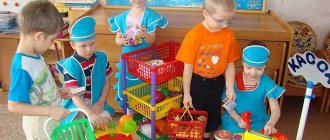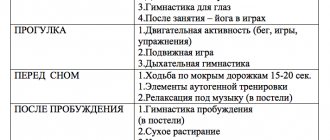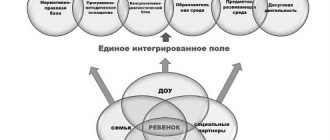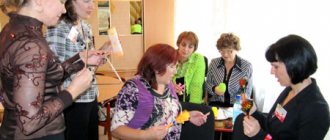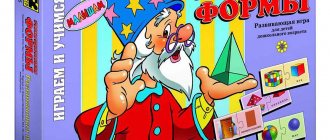Playing with musical instruments in kindergarten "Epoy Tai Tai E"
Teachers often use games with musical instruments in kindergarten in their work with children. Such games develop students' skills in playing various children's musical instruments and introduce them to playing techniques, for example, hitting or shaking. Of course, every time children hear better and better the change of parts and phrases in music, they catch the rhythm. By interacting with the music director and with each other, preschoolers develop their communicative skills.
It is always interesting to know how teachers work with preschoolers in other countries. Playing at a music lesson in kindergarten “Epoy Tai Tai E”. It is valuable that when moving around the circle, each child can play different noise musical instruments.
Gaming technologies in music classes at preschool educational institutions
Gaming technologies in music classes at preschool educational institutions
Play is the main activity of a child. This is a free and independent activity that arises on the initiative of the child. The whole personality of the child is involved in the game process: cognitive processes, will, feelings, emotions, needs, interests. As a result, amazing changes occur in this personality. A game is a very specific type of activity, which has all the characteristics of an activity, but all of them are special.
Every activity has a purpose. What is the goal of the game? In fact, the game has a goal, not obvious, but no less significant than the goal of any other activity. This is the child’s awareness of himself as involved in the world of adults, transference into “adult” life.
What is the content of gaming activity? The game is, as it were, given by nature itself, so that the child prepares for adult life.
When we talk about activity, we also talk about its process. If in any other non-game activity the goal, the result, is important first of all, then in a game it is mainly the process that is important, since the game does not seem to have a visible goal. It is the interest in the game process itself that is the driving force that allows the game to last.
Any activity can take place as an amateur activity. The game is always an amateur activity. For example, you can work with both joyful feelings and hostility. Playing without having fun is impossible. The game is always joyful for those who play. If negative emotions arise in the game, then it stops and falls apart.
As already mentioned, a game is a type of activity whose motive lies not in the results, but in the process itself. For a child, play is a means of self-realization and self-expression. She allows him to go beyond the limited world of the nursery and build his own world. The game provides the child with emotional well-being, allows him to realize a variety of aspirations and desires and, above all, the desire to act like adults, the desire to control objects.
The game develops the ability to imagine and think creatively.
In the game, the child also gains experience of voluntary behavior, learns to control himself, observing the rules of the game.
Let us turn to the game as a pedagogical category. Since play occupies a huge place in development, it has long been used as a pedagogical tool.
Play in the pedagogical process can “merge” with other types of activities, enriching them. For example, it is well known that the merging of work and play activities in childhood has a positive effect. In addition, didactic games occupy a special place in pedagogy, significantly enriching the learning process.
What tasks can gaming activities help a teacher accomplish? First of all, it is establishing contact with the child. Speaking about this method of establishing contact, teachers call it contact of community, co-creation, the best way to enter into a trusting, friendly relationship with a child.
The game is also an excellent diagnostic tool for both individuals and groups. In addition to the personal development of the child, the game allows you to establish what the child strives for and needs, since in the game he strives to take the desired role. If a child does not want to do any work, if he is not interested in learning, then the game can come to the rescue, because it is a powerful stimulant.
The concept of “game pedagogical technologies”
includes a fairly extensive group of methods and techniques for organizing the pedagogical process in the form of various pedagogical games.
Unlike games in general, a pedagogical game has an essential feature - a clearly defined learning goal and a corresponding pedagogical result.
The game form of classes is created by game motivation, which acts as a means of inducing and stimulating children to educational activities.
The implementation of gaming techniques and situations in the classroom takes place in the following main areas:
- a didactic goal is set for children in the form of a game task;
- educational activities are subject to the rules of the game;
- educational material is used as its means;
- an element of competition is introduced into educational activities, which transforms a didactic task into a game one;
- successful completion of a didactic task is associated with the game result.
The place and role of gaming technology in the educational process, the combination of game and learning elements largely depend on the teacher’s understanding of the functions and classification of pedagogical games.
Based on the nature of the pedagogical process, the following groups are distinguished:
- teaching, training, controlling and generalizing;
- cognitive, educational, developmental;
- reproductive, productive, creative;
- communicative, diagnostic, psychotechnical, etc.
The specifics of gaming technology are largely determined by the gaming environment: there are games with and without objects, board-print games; indoor, outdoor, on the ground, computer, as well as with various means of transportation.
Game functions.
Game is a complex and multifaceted phenomenon. The following functions can be distinguished:
Communication function
– uniting children and adults, establishing emotional contacts, developing communication skills.
Relaxation function –
relieving emotional (physical) stress caused by the load on the child’s nervous system during intensive study and work.
Compensatory function
– creating conditions for satisfying personal aspirations that are not feasible (difficult to achieve) in real life.
Psychotechnical function
– formation of skills to prepare one’s psychophysical state for more effective activities, restructuring of the psyche for intensive assimilation.
Educational function
– development of general educational skills such as memory, attention, perception and others.
Entertainment function
– creating a favorable atmosphere in the classroom, transforming a lesson and other forms of communication between an adult and a child from a boring event into an exciting adventure.
Self-expression function
– the child’s desire to realize his creative abilities in play and to more fully discover his potential.
Methodology for organizing didactic games.
The organization of didactic games by the teacher is carried out in three main directions: preparation for the didactic game, its conduct and analysis
Preparation for conducting a didactic game includes:
- selection of games in accordance with the objectives of education and training: deepening and generalizing knowledge, developing sensory abilities, activating mental processes (memory, attention, thinking, speech), etc.;
- establishing compliance of the selected game with the program requirements for the education and training of children of a certain age group;
- determining the number of players (the whole group, small subgroups, individually);
- preparation of the necessary did. material for the selected game (toys, various objects, pictures, etc.);
- preparation of the teacher himself for the game: he must study and comprehend the entire course of the game, his place in the game, methods of managing the game;
- preparing children for play: enriching them with knowledge, ideas about objects and phenomena of the surrounding life necessary to solve a game problem.
Conducting didactic games includes:
- familiarizing children with the content of the game, with did. material that will be used in the game (showing objects, pictures, a short conversation, during which children’s knowledge and ideas about them are clarified);
- explanation of the course and rules of the game;
- demonstration of game actions, during which the teacher teaches children to perform the action correctly;
- determining the role of the teacher in the game, his participation as a player, fan or referee. The degree of direct participation of the teacher in the game is determined by the age of the children, their level of training, and the complexity of the task. tasks, game rules;
- summing up the game is a crucial moment in its management, because Based on the results that children achieve in the game, one can judge its effectiveness and whether it will be used with interest in children’s independent play activities. When summing up the results, the teacher emphasizes that the path to victory is possible only through overcoming difficulties, attention and discipline.
At the end of the game, the teacher asks the children if they liked the game and promises that next time they can play a new game, it will be also interesting. Children usually wait for this day.
Analysis of the game
is aimed at identifying methods of its preparation and implementation: which methods were effective in achieving the goal, what did not work and why. This will help improve both the preparation and the process of playing the game, and avoid subsequent mistakes. In addition, the analysis will allow us to identify individual characteristics in the behavior and character of children and, therefore, correctly organize individual work with them. Self-critical analysis of the use of the game in accordance with the goal helps to vary the game and enrich it with new material in subsequent work.
Guide to didactic games.
Successful management of didactic games primarily involves selecting and thinking through their program content, clearly defining tasks, determining their place and role in the holistic educational process, and interaction with other games and forms of education. It should be aimed at developing and encouraging children’s cognitive activity, independence and initiative, their use of different ways to solve game problems, and should ensure friendly relations between participants and a willingness to help their comrades.
When playing with toys, objects, materials, small children should be able to knock, rearrange, rearrange them, disassemble them into their component parts (collapsible toys), put them back together, etc. But since they can repeat the same actions many times, the teacher needs to gradually change the game
The development of interest in didactic games and the formation of play activities in older children (4-6 years old) is achieved by the fact that the teacher sets increasingly more complex tasks for them and is in no hurry to suggest play actions. The play activity of preschoolers becomes more conscious; it is more aimed at achieving a result, and not at the process itself. But even for older preschoolers, the management of the game should be such that the children maintain an appropriate emotional mood, ease, so that they experience the joy of participating in it and a sense of satisfaction from solving the assigned tasks.
The teacher outlines a sequence of games that become more complex in content, didactic tasks, game actions and rules. Individual isolated games can be very interesting, but using them outside the system cannot achieve an overall educational and developmental result. Therefore, the interaction of learning in the classroom and in the didactic game should be clearly defined.
It should be taken into account that in a didactic game, the correct combination of clarity, the words of the teacher and the actions of the children themselves with toys, play aids, objects, etc. is necessary.
When directing games, the teacher uses a variety of means of influence on preschoolers. For example, acting as a participant in the game, he directs the game unnoticed by them, supports their initiative, and empathizes with them the joy of the game. Sometimes the teacher talks about an event, creates the appropriate gaming mood and maintains it during the game. He may not be involved in the game, but as a skillful and sensitive director, preserving and preserving its amateur character, he guides the development of game actions, the implementation of the rules and, unnoticed by the children, leads them to a certain result. When supporting and awakening children's activity, the teacher most often does this not directly, but indirectly: he expresses surprise, jokes, uses various kinds of playful surprises, etc.
We must remember, on the one hand, the danger of over-intensifying the teaching moments, weakening the beginning of the game, giving the didactic game the character of an activity, and, on the other hand, being carried away by the entertainment, escaping from the task of teaching.
The development of the game is largely determined by the pace of children’s mental activity, the greater or lesser success of performing game actions, the level of assimilation of the rules, their emotional experiences, and the degree of enthusiasm. During the period of assimilation of new content, new game actions, rules and the beginning of the game, its pace is naturally slower. Later, when the game unfolds and the children get carried away, its pace quickens. By the end of the game, the emotional upsurge seems to subside and the pace slows down again.
When finishing the game, the teacher should arouse children’s interest in continuing it and create a joyful prospect. Usually he says: “The new game will be even more interesting.” The teacher develops versions of games familiar to children and creates new ones that are useful and exciting.
Pedagogical value of didactic games.
In didactic games, children are given certain tasks, the solution of which requires concentration, attention, mental effort, the ability to comprehend the rules, sequence of actions, and overcome difficulties.
They promote the development of sensations and perceptions in preschoolers, the formation of ideas, and the acquisition of knowledge
These games make it possible to teach children a variety of economical and rational ways to solve certain mental and practical problems. It is necessary to ensure that didactic play is not only a form of assimilation of individual knowledge and skills, but also contributes to the overall development of the child and serves to shape his abilities.
The didactic game helps solve the problems of moral education and develop sociability in children. The teacher places children in conditions that require them to be able to play together, regulate their behavior, be fair and honest, compliant and demanding.
3. IMPLEMENTATION OF GAME TECHNOLOGY INTO PRACTICE.
In my classes I use the following types of didactic games:
- role-playing;
- movable;
- desktop
Each game has its own task aimed at perceiving various properties of sound.
Characteristic of each didactic game is the presence in it of:
- learning task;
- contents and rules;
- game actions.
I use the following types of musical and didactic games:
- for the development of pitch hearing;
- to develop a sense of rhythm;
- on the development of timbre hearing;
- for the development of memory and hearing;
- for the development of children's creativity.
I use musical teaching aids and games:
- in the process of singing;
- while listening to music;
- in the process of rhythmic movements;
- while playing children's musical instruments.
Gaming technologies in music classes at preschool educational institutions
Childhood is a special world that remains in a person’s soul for the rest of his life if happiness and joy of being oneself reign in it. The world of fantasy and fiction in children is associated with play
. In all historical times, children of different nations played and play, imitating adults, realizing their desires and creative abilities.
The most useful games for a child of senior preschool age are those that focus on the development of cognitive abilities, attention, memory, and thinking.
The development of a child depends on the conditions of upbringing and education in kindergarten and in the family. The task of teachers, musical
leaders and parents - to contribute in every possible way to the full development of children, and pedagogical
technologies
.
What is pedagogical (educational) technology ?
Under educational technology
refers to an ordered system of actions, the implementation of which leads to the guaranteed achievement of pedagogical goals.
Thus, technology
reflects the sequence of pedagogical activity, its logic and therefore is always represented by stages of activity, each of which has its own goal. Only after achieving the goal of one stage does the transition to the next stage of activity occur.
Moreover, the first stage of any technology is diagnostic
, and this is the distinctive feature
of technology
from traditional teaching methods.
To implement the technological
approach, detailed information about the initial state of each child is needed. The initial object of the teaching methodology is the “average” preschooler (a pupil whose initial state does not matter for constructing a methodological system.
Types of educational technologies
• “Health-saving”
technology
• “TRIZ” technology
• Problem-based learning technology
• Maria Montessori technology
.
• " Game "
, etc.
Game pedagogical technology
— organization of the pedagogical process in the form of various pedagogical games. This is the consistent activity of the teacher in:
• selection, development, preparation of games;
• inclusion of children in play activities
;
• implementation of the game itself;
• summing up the results of gaming activities
.
Pedagogical technology of music
education is a tool that allows
the music
director of a preschool educational institution to effectively solve the problems of his professional activity.
Unlike methods, methods and techniques, pedagogical technology allows musical
the manager should not only state:
“I know how
,” but also answer the question
“Why am I doing this
.
In addition, the use of pedagogical technologies
makes the process of solving problems consistent, orderly, thoughtful and conscious, allowing the teacher to achieve the planned result.
This is a very important point, since technology
is one of the characteristics of a teacher in the 21st century.
Gaming technologies in music classes
:
• technology
elementary music playing - use
technology T
.
E. Tyutyunnikova “Elementary music-making with preschoolers”
promotes the development of their creative abilities, natural
musicality
, creates conditions for broad orientation in
music
and the accumulation of a stock of
musical impressions
, and helps to successfully solve the problems of the preschool education program.
This technology
includes rhythmic games with various objects (game with sticks, game with spoons, game with buckets, with cups, with balloons, with balls, paper orchestra, etc.)
• Igrorhythmics
– is the basis for the development of a sense of rhythm and motor abilities of students, allowing them to freely, beautifully and correctly perform movements to
music
in accordance with its character, rhythm, and tempo.
This section includes special exercises for coordinating movements with music
,
musical tasks and games
.
Goal: to develop children's sense of rhythm and motor abilities. Teach children to perform movements to music beautifully
, freely, and with coordination.
• Game gymnastics
– serves as the basis for the child to master various types of movements, ensuring the effective formation of skills and abilities necessary when learning dance movements: to strengthen posture, to relax muscles, rhythmic exercises
( game massage , finger games)
• Technology
The practical development
of musical
information is based on the application of acquired knowledge, on the activation of auditory perception and imaginative
musical thinking
.
At the initial stage of learning, the child’s practical activity is manifested in various actions with rhythmic, sound or theoretical material. To organize such activities, visual aids are needed: cards, lotto, pictures, tables. Operating with auxiliary objects reinforces previously obtained sound images and theoretical information. The manifestation of student independence leads to the development of creative abilities. This technology includes
: listening to
music
, thinking about
music
, singing in chorus, games:
“guess the melody”
,
“what am I playing”
,
“What is music ”
, “
, etc. d.
• theater and gaming technology
.
Theatrical and gaming technology
has a special place in the work
of a music director
.
The main task of work in this direction is the development of theatrical abilities of preschool children through all types of musical activities
.
In working with children in preschool educational institutions, musical performances and musical
-rhythm games are of great importance. Development of a sense of rhythm, speech, singing breathing, coordination of movements, sense of orientation in space, expansion of the singing and speech range.
Songs - dramatizations, theatrical musical miniatures
,
musical
-rhythmic games and exercises, recitation to
music
.
Classification of songs for dramatization:
Folklore songs – round dances
Children's pop song
Singing songs
Songs - noisemakers.
Songs - dramatizations, such as “Two Cheerful Geese”
,
“Little Hedgehog”
,
“Antoshka”
and others, allow
children to develop creative abilities, communication skills, and emotions in children music classes
• dance - gaming technology
.
Igrodance
- a new term in the field of choreography.
Two words that are so clear and familiar to everyone. What is the main thing in the game? Someone will say that it is getting pleasure, someone will remember joy. What is the main thing in dance? Firstly - movement, secondly - rhythm, thirdly - music
.
That is, dance is a rhythmic movement to music
that brings joy, pleasure, and instills confidence in one’s abilities.
Igrodance includes
: dance
game songs
, mass dances, show dances (mirror dance, rhythm games, animated dances. Each
game dance
is aimed at developing a sense of rhythm, creating a special atmosphere, and the ability to quickly change roles.
In a music lesson
games are developmental in nature and are aimed at children mastering motor and intellectual skills, sensory abilities, developing cooperation skills, effective interaction based on cognitive interests.
In a music game
As in singing and rhythmic movements, children master the means of artistic expression characteristic of
music and speech - rhythm
, dynamics, tempo, pitch.
This gives the teacher the opportunity to differentially influence children with different rates of development. games with musical
accompaniment.
Music
helps to find the necessary motor pattern, gives plasticity and expressiveness to movements.
Through musical
play, children's abilities develop naturally and harmoniously.
The use of musical and gaming technologies will help the musical
the leader can conduct this or that section
of the lesson more entertainingly and effectively - singing
, listening, improvising.
Literature
1. Anisimova G. I. “100 musical games for the development of preschoolers”
, Yaroslavl
"Academy of Development"
2007.
2. Davydova M. A. “ Musical education in kindergarten”
,M.
"Waco"
2006.
3. Selevko G. K. “Modern educational technologies ”
, M. 2006.
4. Kasatkina E.I. Game in the life of a preschooler. - M., 2010.
5. Kasatkina E. I. Gaming technologies
in the educational process of preschool educational institutions. //Management of preschool educational institution. - 2012. - No. 5.
6. Karpyuk G. A. Realization of the child’s right to play. //Senior teacher. — 2007 — No. 6.
7. Penkova L. A., Konnova Z. P. Game
activity of preschoolers.
Shmakov S. A. “Student games - a cultural phenomenon”
, - M.: New School, 1999.
8. Shchurkova N. E. “Workshop on pedagogical technology ”
, M. 2001.
8
Children's outdoor games to music
Pay attention to how children react to the sounds of music. Their body parts begin to tap, stomp to the beat and eventually they break into a dance that cannot be limited by any dance in the world. Their movements are unique and original, in a word, individual. Due to the fact that children are so sensitive to music, they are very fond of children's outdoor games accompanied by music. In turn, such games help them open up and reveal their talents: musical, singing. Children become more sociable, easily making contact with the team.
Another big advantage of outdoor games accompanied by music is that all useful information for the child comes in an easy playful form, which simplifies the learning process and makes it attractive.
All this, together with active actions such as walking, running, arm movements, jumping, squats and many others, has a positive effect on the physical development of the child.
Below we will look at the main and popular outdoor games with music for children.
Children stand in a circle, each remembering their place - who is behind whom. After the command “Disperse!” Cheerful music starts playing, children run around. During one period of the game, the music should change in tempo, slow - walking, fast - running.
Progress of the game:
Before the game starts, children form 2 circles, one in one. Those in the inner circle join hands - during the game they depict nets. The players in the outer circle do not hold hands; they are fish. To the music, the nets move in a round dance step to the right, and the fish one after another to the left (toe step, arms slightly pulled back, palms moving, imitating the movements of the fins).
Everyone sings:
“As fishermen went out to sea to fish for cod,
They set up the nets and sing a song.”
Then everyone stops. The players in the inner circle raise their joined hands up and sing: “Catch you, cod, get caught, get caught in our nets!”
A wonderful catch awaits the fishermen today!”
At this time, the players of the outer circle - the cod - can freely run in and out of the nets. The net cannot catch the fish.
At the last word of the song, the net is lowered, that is, all the players in the inner circle lower their joined hands down and squat. Caught "fish"
becomes an inner circle, which increases in size, after which the game resumes, or the players -
“fish”
and the players -
“nets”
change roles.
13 Autumn Leaves
CHILDHOOD GUIDE
- From work experience
- "Children's outdoor games to music"
- Mitina Olga Yurievna,
- physical education instructor MBDOU No. 38,
Zapolyarny, Murmansk region.
Music and movement occupy a special, unique place in the education of preschool children.
Pay attention to how children react to the sounds of music. Their body parts begin to tap, stomp to the beat and eventually they break into a dance that cannot be limited by any dance in the world. Their movements are unique and original, in a word, individual. Due to the fact that children are so sensitive to music, they are very fond of children's outdoor games accompanied by music.
In turn, such games help them open up and reveal their talents: musical, singing. Children become more sociable, easily making contact with the team.
Another big advantage of outdoor games accompanied by music is that all useful information for the child comes in an easy playful form, which simplifies the learning process and makes it attractive. All this, together with active actions such as walking, running, arm movements, jumping, squats and many others, has a positive effect on the physical development of the child.
- Below I want to offer several outdoor games that can be used both in physical education classes and sports events and entertainment.
- Outdoor game "Beads"
- Purpose of the game: To develop memory, speed-strength qualities, the vestibular apparatus, rhythm of movements and the ability to coordinate them with words; promote the formation of the skill of correct posture; skill of jumping on a fitball, increasing emotional tone.
- Progress of the game: Using a counting rhyme, one child is selected - a “needle”, whose task is to collect all the other children - “beads” on a string to make beads.
- Children, sitting on balls in a circle, perform springing movements and pronounce the words:
- We are beads - beauties,
- We're hanging by threads.
- We are beads - beauties,
- We ring, we ring, we ring.
- We're off the hook,
- They scattered across the floor.
- We need to catch up with us quickly
- And collect it on a thread.
- The teacher turns on any cheerful rhythmic music, and then all the “beads” together with the “needle” begin to jump on their balls throughout the hall, in different directions.
- As soon as the teacher turns on any lyrical music, all the “beads” stop and perform springy movements in place (where they stopped). And the “needle”, jumping on its ball, begins to collect beads:
- - whichever “bead” the “needle” touches with its hand, that “bead” should jump after it, and so on until everyone gathers “on a string”, and then forms one circle of “beads”.
- Outdoor game "Desert"
- The purpose of the game: awakening curiosity, establishing a comfortable atmosphere, creating an emotional charge, and a joyful mood from the game.
Preliminary work: talk with children about what a desert is. Tell them that there are natural traps there, which are a relatively small sandy field. The sand there has some special, inexplicable viscosity. Stepping on it, a person begins to quickly plunge into its thickness.
- For this game you will need any fun music.
- How to play: All players stand in a circle. The teacher stands in the center of the circle and addresses the participants in the game:
- - Guys, let's imagine that we find ourselves in the desert and, while we are dancing with you, the “sands of the desert” will gradually suck our body down.
- The teacher turns on cheerful, incendiary music and gives commands:
- - “the desert sands sucked us in up to our ankles” - everyone dances without lifting their feet from the floor;
- - “the sands sucked us in up to our knees” - the hips and upper body dance;
- - “the sands have sucked our feet” - we dance without the help of our feet;
- - “the sands sucked us in up to our waists” - we dance only with the upper part of the body”;
- - “the sands sucked us in up to our chests” - shoulders and arms dance.
- - “the sands sucked us up to our necks” - we dance with our heads and facial expressions.
- - “the sands sucked us in up to our noses” - we dance with our eyes.
- The game continues 2-3 times.
- Throughout the game, the teacher marks those children who never made a mistake and completed all the tasks correctly.
- Outdoor game "Pultyashka"
Objectives: To develop in children the ability to perform movements according to a verbal signal. Practice walking in a certain direction and pace. Develop reaction speed, attentiveness, imagination. Develop the ability to work harmoniously in a team.
Preliminary work: talk with children about what functions the remote control can perform when watching TV.
The best outdoor musical games for children
Children have a special relationship with music. They easily respond to both the melody itself and the meaning of the text, and can begin to move or even dance. That's why children really love musical games with movements - during such games you can have a lot of fun and never get bored!
In turn, musical games are very useful for children of preschool and primary school age. They develop a sense of rhythm, artistry and coordination of movements, help develop creative abilities, teach how to get along with people and establish contact with them. This is a wonderful way to spend time outside and indoors in an interesting and useful way, but it should be noted that most outdoor games require free space.
We bring you a selection of the five best children's music games with movements that are suitable for children from 3 to 10 years old.
Game "Chairs"
This ancient children's game is probably known to everyone. In the middle of the room, chairs are placed in a circle, the number of which is one less than the number of children. The adult presenter plays cheerful music, to which everyone dances around the chairs. As soon as the music stops, the players must take each of their chairs. The one who does not get a chair is eliminated, and he takes one chair with him. Thus, there is always one less chair than players.
Game "Wolf Under the Mountain"
Among the children, the one who will play the wolf is chosen, the rest are considered geese. The wolf is hiding somewhere in a secluded place - “under the mountain.” Children pretend to be geese and walk to calm music. As soon as the music changes to louder and faster, a wolf jumps out and tries to catch the geese for himself. The last one caught becomes a wolf himself.
Game "Magic Hat"
Before starting this active musical game for children, you need to prepare a big hat. The more unusual it looks, the more “magical” it will seem.
Children and the leading adult stand in a circle, with the leader holding a hat. The music turns on, and the hat begins to be passed around in a circle, from hand to hand. Suddenly the music ends. The one who has a hat in his hands must put it on his head. The hat “works magic” and turns the player into some character. You need to go to the center of the circle and portray someone: a fairy-tale character, an animal or an object, while you cannot use words, only sounds, movements and facial expressions. The rest of the game participants must guess who the owner of the magic hat is portraying. The one who guessed correctly gets a hat, everyone stands in a circle again and the game continues.
Musical game "Mirror"
A leader is selected who faces everyone else. He will be the main leader, and the rest will be his reflections in the mirror. To the accompaniment of cheerful and mischievous music, the presenter begins to show various movements, which the “reflections” must repeat exactly. It can be jumping, squats, swinging arms or legs, dance steps - anything. At the end of the melody (usually 2-2.5 minutes), a new presenter is selected.
Game "Unusual dances"
5 short musical compositions are selected. To the first of them you need to dance only with your hands, to the second - only with your feet, then only with your head, then - only with your face, and finally, all together.
All these active musical games for children will be great entertainment at any children's party, event, or just while walking with several children at the same time. If you want to use them outdoors, instead of playing recorded music, you can simply play short songs or even hum melodies without any words.
Outdoor games
- Dynamic outdoor game “Pilots” -
to the Kholodnaya airfield I.V 06:12 - Unknown -
Game pilots at the Kholodnaya airfield I.V 06:12 - music games –
Untitled – 1 01:09 - Music for competitions -
Music for outdoor games and competitions 03:17 - Outdoor game -
Rainbow 03:01 - Game -
Birds and Blizzard 01:57 - no artist -
Relay race for games 04:02
(arr. O. Myachikova) —
outdoor game “At the bear in the forest” (younger group) 00:53
- Unknown -
Outdoor games 02:52 - Children's music -
Movable for play 03:31 - Unknown -
Outdoor game “Visiting” 03:46 - Unknown -
outdoor game for kids “Teddy Bear” 01:28 - Musical game -
Arms-legs-head 02:42 - Outdoor game -
Traffic light 01:18 - outdoor game -
I'll show the sun 01:49 - Children's -
mobile 03:31 - Outdoor game -
magic handkerchief 02:48 - Outdoor game -
Inflate our bubble 01:19
Limpopo. Outdoor games and songs for children. S. and E. Zheleznov. Music with mom. —
Here's the left one, here's the right one.. girlfriends 01:20
Limpopo. Outdoor games and songs for children. S. and E. Zheleznov. Music with mom. —
Giraffes, elephants, kittens, zebras... 01:26
Outdoor game —
Hares and fox 01:01
Zheleznovs. Outdoor games-songs for children. —
The giraffe has spots... 01:26
Limpopo. Outdoor games-songs for children. —
We kick top top 01:43
Limpopo. Outdoor games and songs for children. S. and E. Zheleznov. Music with mom. —
Worm Dance 01:30
A game —
Hares and wolf 01:11
Source: https://hotplayer.ru/?s=%D0%BF%D0%BE%D0%B4%D0%B2%D0%B8%D0%B6%D0%BD%D1%8B%D0%B5% 20%D0%B8%D0%B3%D1%80%D1%8B
